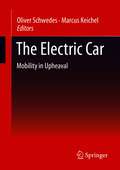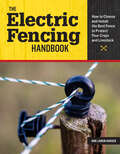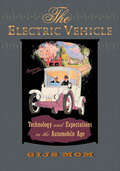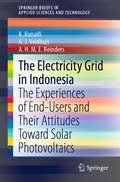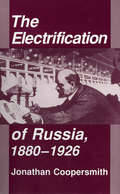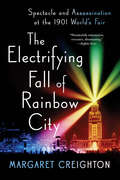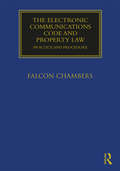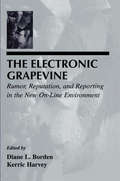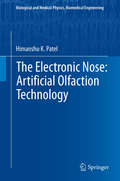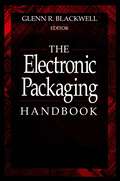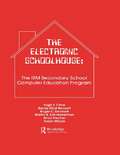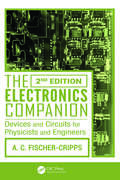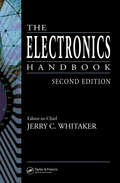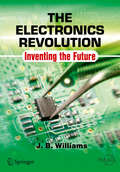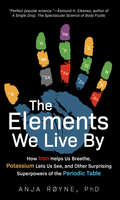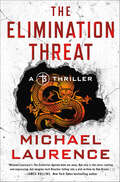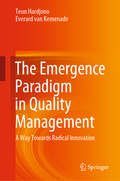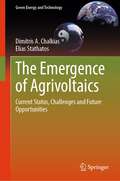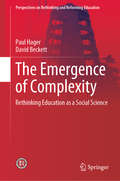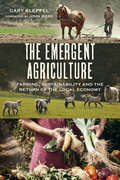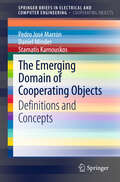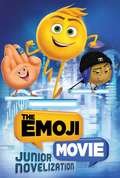- Table View
- List View
The Electric Car: Mobility in Upheaval
by Oliver Schwedes Marcus KeichelThe volume is dedicated to the electric car. It examines the extent to which the electric car can contribute to sustainable transport development as part of a new mobility culture. The technical, cultural, political, social and aesthetic dimensions are considered. It will be shown how the general social framework has to change in order to make the electric car a success.This book is a translation of the original German edition "Das Elektroauto“ by “Marcus Keichel”, published by Springer Fachmedien Wiesbaden in 2013. The translation was done with the help of artificial intelligence (machine translation by the service DeepL.com). A subsequent human revision was done primarily in terms of content, so that the book will read stylistically differently from a conventional translation. Springer Nature works continuously to further the development of tools for the production of books and on the related technologies to support the authors.
The Electric Fencing Handbook: How to Choose and Install the Best Fence to Protect Your Crops and Livestock
by Ann Larkin HansenUse electric fencing to protect your livestock, poultry, beehives, and garden. Portable electric fencing is key to successful rotational grazing, while permanent electric fencing effectively protects gardens and orchards and secures large pastures. Through clear instructions accessible to everyone, you’ll learn when to use these methods or a combination of the two, plus how to plan for, build, and maintain your electric fencing. This crucial tool is cost effective and versatile, but veteran farmer and author Ann Larkin Hansen also explains what not to do with an electric fence.
The Electric Theories of J. Clerk Maxwell
by Pierre Maurice Marie DuhemIn this volume Pierre Duhem first gives an overview of 19th century electricity and magnetism. Next, he applies his keen historical, philosophical, and physical intuition to critiquing Maxwell's theories, especially his electromagnetic theory of light and the ad hoc introduction of displacement current, which he considers too much a product of the "esprit de géométrie" than the "esprit de finesse," as Pascal calls it. In this book, Duhem is guided by the principle that a theory that offers contradictions, even if the theory is posed by a genius, needs to be analysed and discussed until a clear distinction can be made between the propositions likely to be logically demonstrated and statements that offend logic and which must be transformed or rejected. Furthermore, Duhem felt, in criticizing such a theory one must guard against narrowness of mind and petty corrections which would make one forget the merit of the inventor; and, more importantly, one must guard against the blind superstition which, for admiration of the author, would hide the serious defects of the work. He is not so great a genius that he surpasses the laws of reason. Pierre Duhem (1861-1916), chairman of theoretical physics at Bordeaux in 1984-1916, is well-known for his works in the history and philosophy of science.
The Electric Vehicle: Technology and Expectations in the Automobile Age
by Gijs MomWinner of the Engineer-Historian Award from the International History and Heritage Committee of the American Society of Mechanical Engineers, and the Nicholas-Joseph Cugnot Award given by the Society of Automotive HistoriansRecent attention to hybrid cars that run on both gasoline and electric batteries has made the electric car an apparent alternative to the internal combustion engine and its attendant environmental costs and geopolitical implications. Few people realize that the electric car—neither a recent invention nor a historical curiosity—has a story as old as that of the gasoline-powered automobile, and that at one time many in the nascent automobile industry believed battery-powered engines would become the dominant technology. In both Europe and America, electric cars and trucks succeeded in meeting the needs of a wide range of consumers. Before World War II, as many as 30,000 electric cars and more than 10,000 electric trucks plied American roads; European cities were busy with, electrically propelled fire engines, taxis, delivery vans, buses, heavy trucks and private cars. Even so, throughout the century-long history of electric propulsion, the widespread conviction it was an inferior technology remained stubbornly in place, an assumption mirrored in popular and scholarly memory. In The Electric Vehicle, Gijs Mom challenges this view, arguing that at the beginning of the automobile age neither the internal combustion engine nor the battery-powered vehicle enjoyed a clear advantage. He explores the technology and marketing/consumer-ratio faction relationship over four "generations" of electric-vehicle design, with separate chapters on privately owned passenger cars and commercial vehicles. Mom makes comparisons among European countries and between Europe and America.He finds that the electric vehicle offered many advantages, among them greater reliability and control, less noise and pollution. He also argues that a nexus of factors—cultural (underpowered and less rugged, electric cars seemed "feminine" at a time when most car buyers were men), structural (the shortcomings of battery technology at the time), and systemic (the infrastructural problems of changing large numbers of batteries)—ultimately gave an edge to the internal combustion engine. One hopes, as a new generation of electric vehicles becomes a reality, The Electric Vehicle offers a long-overdue reassessment of the place of this technology in the history of street transportation.
The Electricity Grid in Indonesia: The Experiences of End-Users and Their Attitudes Toward Solar Photovoltaics (SpringerBriefs in Applied Sciences and Technology)
by K. Kunaifi A.J. Veldhuis A.H.M.E ReindersIn 2017, nearly 60 million households in Indonesia were connected to the national power grid. Accordingly, we believe that their ‘voice’ is important to maintain democratic and participatory values in planning electricity services. However, what is actually the voice of electricity users in Indonesia? Also, what can we learn from it when looking at the fitness of the electricity supply in Indonesia in the context of costs, reliability, and environmental aspects? This book presents the real experience of households, some of the grid users in Indonesia. Through a series of surveys in 2017, households in three cities in Western, Central, and Eastern Indonesia shared their experiences and preferences regarding their electricity supply. They offered their opinions about the stability and reliability of electricity supply, how they coped with blackouts, and what impacts power interruptions had on their daily lives. Because of the frequent power outages, the users started to think about the importance of having a back-up power generator at home. Given that Indonesia has high solar irradiance the whole year through, we also observed the users’ attitudes toward solar photovoltaic (PV) systems. The book starts with a brief introduction about Indonesia followed by the status and challenges of power supply in the country. Then, in the middle section, the users’ voices are presented. Finally, the potential of PV systems, as a promising solution to increasing electricity access and improving the reliability of electricity supply in this tropical country, is presented. We believe that this book provides useful information for the transition to the use of solar energy in energy systems in Indonesia, which is meant for academia, electric utility companies, PV system actors, policymakers, and of course, households in Indonesia.
The Electrification of Russia, 1880–1926
by Jonathan CoopersmithThe Electrification of Russia, 1880–1926 is the first full account of the widespread adoption of electricity in Russia, from the beginning in the 1880s to its early years as a state technology under Soviet rule. Jonathan Coopersmith has mined the archives for both the tsarist and the Soviet periods to examine a crucial element in the modernization of Russia. Coopersmith shows how the Communist Party forged an alliance with engineers to harness the socially transformative power of this science-based enterprise. A centralized plan of electrification triumphed, to the benefit of the Communist Party and the detriment of local governments and the electrical engineers. Coopersmith’s narrative of how this came to be elucidates the deep-seated and chronic conflict between the utopianism of Soviet ideology and the reality of Soviet politics and economics.
The Electrifying Fall of Rainbow City: Spectacle and Assassination at the 1901 World's Fair
by Margaret CreightonThe Pan American Exposition in Buffalo, New York, meant to herald the twentieth century, went tragically, spectacularly awry. In 1901, Buffalo was the eighth-largest city in the United States, and its leaders had big dreams. They would host a world’s fair, showcasing the Americas, and bring millions of people to western New York. With nearby Niagara Falls as a drawing card and with stunning colors and electric lights, they hoped the fair would be more popular and more brilliant, literally, than Chicago’s White City of 1893. The Exposition opened with fanfare; its wonders, both strange and magnificent, dazzled the public. Then tragedy struck. In the early autumn of 1901, an assassin stalked the fairgrounds, waiting for President William McKinley. That was shocking enough, but there were more surprises in store. A female daredevil captivated crowds by trying to ride a barrel over Niagara Falls. Apache leader Geronimo startled visitors with a controversial performance. And a showman called the Animal King, the self-proclaimed star of the Midway, announced that one of his acts, the smallest woman in the world and the fair’s “mascot,” had been kidnapped. Then he staged the attempted electrocution of an elephant. In this extraordinary account, Margaret S. Creighton lifts the curtain on the assassination of McKinley as well as on the fair’s lesser-known battles, involving both notorious and forgotten figures. In a story that is by turns suspenseful, heartrending, and triumphant, she reveals the myriad power struggles that not only marked the Exposition but shaped the new century.
The Electronic Communications Code and Property Law: Practice and Procedure
by Falcon ChambersLife now without access to electronic telecommunications would be regarded as highly unsatisfactory by most of the UK population. Such ready access would not have been achieved without methodical and ultimately enforceable means of access to the land on which to install the infrastructure necessary to support the development of an electronic communications network. Successive governments have made such access a priority, regarding it as a principle that no person should unreasonably be denied access to an electronic communications network or electronic communications services. The enactment of the Telecommunications Act 1984 and its revision by the Communications Act in 2003 have played their role in the provision of an extensive electronic infrastructure in the UK, while their reshaping by means of the Digital Economy Act 2017 will continue that process. Throughout that process, a little publicised series of struggles has taken place between telecommunications operators and landowners, as they seek to interpret the Electronic Communications Code by which their rights and obligations have been regulated. This book describes the problems that accompanied the Old Code (which will continue to regulate existing installations and agreements); and the intended solutions under the New Code. The eminent team of authors explain the background, provisions and operation of the old code and the new one, providing practical and jargon-free guidance throughout. It is sure to become the reference on this topic and is intended as a guide for telecommunications operators, land owners, and of course for their advisers in the legal and surveying professions. All members of Falcon Chambers, comprising nine Queen’s Counsel and 30 junior barristers, specialise in property law and allied topics, including the various incarnations of the Electronic Communications Code. Members of Falcon Chambers, including all the authors of this new work, have for many years lectured and written widely on the code, and have appeared (acting for both operators and landowners) in many of the few reported cases on the subject of the interface between property law and the code, including for example: Geo Networks Ltd v The Bridgewater Canal Co. Ltd (2010); Geo Networks Ltd v The Bridgewater Canal Co. Ltd (2011); Crest Nicholson (Operations) Ltd v Arqiva Services Ltd (2015); Brophy v Vodafone Ltd (2017).
The Electronic Grapevine: Rumor, Reputation, and Reporting in the New On-line Environment (LEA Telecommunications Series)
by Kerric Harvey Diane L. BordenThe widespread use of the Internet as a tool for gathering and disseminating information raises serious questions for journalists--and their readers--about the process of reporting information. Using virtual sources and publishing online is changing the way in which journalism takes place and its effect on the society it serves. USE LAST THREE PARAGRAPHS ONLY FOR GENERAL CATALOGS... The Electronic Grapevine explores the use of online media by reporters in the United States, and examines the impact that usage may have on how journalism is framed in the cultural sphere, as well as how it is conducted in the professional one. It contains a mix of material examining how it feels to "do" online journalism, how it affects those who consume it, different ways that media scholars go about trying to understand it better, and the likely social and cultural impact of Internet-like technologies on the public, at whom all this electronic information is eventually aimed. Drawing from the emerging scholarly work in the field and from the real-life experiences of working journalists, Borden and Harvey collect contributions that examine why journalists use the Internet, what changes it makes in how they approach their jobs, and what differences they see in conducting their daily newsgathering with this medium rather than other methods. The volume also analyses when and why journalists do not use online media and what the impact of the decision to use or not use the Internet may mean for the outer world, whose perceptions of itself are so often shaped by journalistic portrait. This series of thought-provoking, original essays explores the impact of computer-based information and communication services on traditional journalistic routines and practices, and thereby addresses a critical gap in the scholarly literature on communication, law, and culture. Distinguishing between linkage devices like the Internet, and database resources such as LEXIS/NEXIS, America Online, and others, this book examines the ways in which both types of online services may reshape and redefine not only the products of journalistic effort, but the newsgathering process itself.
The Electronic Nose: Artificial Olfaction Technology
by Himanshu K. PatelThis book provides the basics of odor, odor analysis techniques, sensors used in odor analysis and overview of odor measurement techniques. For beginners as well researchers this book is a brief guide for odor measurement and analysis. The book includes a special chapter dedicated to practical implementation of e-nose sensor devices with software utility, which guides students to prepare projects and work in practical analysis. It also includes material from early to latest technology research available in the market of e-nose era. Students and researchers who want to learn the basics of biomedical engineering and sensor measurement technology will find this book useful.
The Electronic Packaging Handbook (Electronics Handbook Series)
by G. R. BlackwellThe packaging of electronic devices and systems represents a significant challenge for product designers and managers. Performance, efficiency, cost considerations, dealing with the newer IC packaging technologies, and EMI/RFI issues all come into play. Thermal considerations at both the device and the systems level are also necessary.The Electronic Packaging Handbook, a new volume in the Electrical Engineering Handbook Series, provides essential factual information on the design, manufacturing, and testing of electronic devices and systems.Co-published with the IEEE, this is an ideal resource for engineers and technicians involved in any aspect of design, production, testing or packaging of electronic products, regardless of whether they are commercial or industrial in nature. Topics addressed include design automation, new IC packaging technologies, materials, testing, and safety.Electronics packaging continues to include expanding and evolving topics and technologies, as the demand for smaller, faster, and lighter products continues without signs of abatement. These demands mean that individuals in each of the specialty areas involved in electronics packaging-such as electronic, mechanical, and thermal designers, and manufacturing and test engineers-are all interdependent on each others knowledge. The Electronic Packaging Handbook elucidates these specialty areas and helps individuals broaden their knowledge base in this ever-growing field.
The Electronic Schoolhouse: The Ibm Secondary School Computer Education Program
by Hugh F. Cline, Randy Elliot Bennett, Roger C. Kershaw, Martin B. Schneiderman, Brian Stecher and Susan WilsonPublished in the year 1985, The Electronic Schoolhouse is a valuable contribution to the field of Education.
The Electronics Companion: Devices and Circuits for Physicists and Engineers, 2nd Edition
by Anthony C. Fischer-CrippsUnderstand Introductory Electronics Updated and expanded with new topics, The Electronics Companion: Devices and Circuits for Physicists and Engineers, 2nd Edition presents a full course in introductory electronics using a unique and educational presentation technique that is the signature style of the author's companion books. This concise yet det
The Electronics Handbook (ISSN)
by Jerry C. WhitakerDuring the ten years since the appearance of the groundbreaking, bestselling first edition of The Electronics Handbook, the field has grown and changed tremendously. With a focus on fundamental theory and practical applications, the first edition guided novice and veteran engineers along the cutting edge in the design, production, installation, operation, and maintenance of electronic devices and systems. Completely updated and expanded to reflect recent advances, this second edition continues the tradition.The Electronics Handbook, Second Edition provides a comprehensive reference to the key concepts, models, and equations necessary to analyze, design, and predict the behavior of complex electrical devices, circuits, instruments, and systems. With 23 sections that encompass the entire electronics field, from classical devices and circuits to emerging technologies and applications, The Electronics Handbook, Second Edition not only covers the engineering aspects, but also includes sections on reliability, safety, and engineering management. The book features an individual table of contents at the beginning of each chapter, which enables engineers from industry, government, and academia to navigate easily to the vital information they need. This is truly the most comprehensive, easy-to-use reference on electronics available.
The Electronics Revolution
by J. B. WilliamsThis book is about how electronics, computing, and telecommunications have profoundly changed our lives - the way we work, live, and play. It covers a myriad of topics from the invention of the fundamental devices, and integrated circuits, through radio and television, to computers, mobile telephones and GPS. Today our lives are ruled by electronics as they control the home and computers dominate the workspace. We walk around with mobile phones and communicate by email. Electronics didn't exist until into the twentieth century. The industrial revolution is the term usually applied to the coming of steam, railways and the factory system. In the twentieth century, it is electronics that has changed the way we gather our information, entertain ourselves, communicate and work. This book demonstrates that this is, in fact, another revolution.
The Elements We Live By: How Iron Helps Us Breathe, Potassium Lets Us See, and Other Surprising Superpowers of the Periodic Table
by Anja RøyneThis “excellent” popular science book explores just what we—and the things around us—are made of (Aftenposten, Norway).Some elements get all the attention: glittering gold, radioactive uranium—materials we call “precious” because they are so rare. But what could be more precious than the building blocks of life—from the oxygen in our air to the carbon in all living things?In The Elements We Live By, physicist and award-winning author Anja Røyne reminds us that we’d be lost without the quiet heroes of the periodic table. Our bodies need phosphorous to hold our DNA together, potassium to power our optic nerves, and many more elements—in just the right amounts—to function. Other fundamental elements keep our technology (and society) running: Our phones contain arsenic, boron, and gallium to control signals and store information; indium and tin for the touch screen; and lithium for the battery.Everything is made of elements—every galaxy, star, and planet—from the iron in Earth’s core to the silicon in its sand. But that doesn’t mean the elements we rely on will never run out; for example, about half the lithium we need is extracted from rocks in Australia, and the other half is from saltwater in Argentina and Chile. As Røyne travels the world to find where these elements exist (some in ever-shrinking amounts), she shows how vitally urgent it is for us to protect them—the elements of our very existence.“Not just a discussion of basic chemistry, this is a volume that looks at the human impact on the planet and what we can learn from nature…Useful for science or sociology courses that address the various impacts of natural resource development or for popular science readers.” —School Library Journal
The Elephant Moon of Sir Herbert Spoon
by Kelly TerwilligerSir Herbert Spoon alerts Cecil Spout, his butler, that he has spotted an elephant on the moon through his telescope.
The Eleventh Off-Campus Library Services Conference Proceedings
by Patrick MahoneyLearn how to provide better service to distance information users! This book is the result of the conference held in May, 2004 in Scottsdale, Arizona, focusing on librarians' challenges providing service to nontraditional faculty and students. Respected authorities discuss in detail specific problems-and fresh strategies and solutions-to further promote service to distance information users. Each chapter tackles a particular issue such as collaboration outside the contributor's organization or how services can be monitored and assessed to gauge quality, and fully explains what can be done to address those issues. Each distinguished contribution was carefully selected by a 26-member advisory board using a juried abstracts process. Thorough bibliographies, useful figures, tables, and graphs provide accessibility and clarify ideas. Some of the topics in this book include: the promotion of library services to Native American students the planning and development process of a project to create a Web-based multi-media instruction tool for off-campus graduate students an examination of direct linking tools provided by major aggregators distance learning for the learning disabled distance learning implementation strategies for institutions course management software (CMS) and library services integration a survey of Association of Research Libraries offered services the do&’s and don&’ts of videoconferencing on and off-campus an eBooks collection study one-on-one research coaching via digital reference service an online tool that assesses students&’ research skills and attitudes creating a library CD for off-campus students expanding student and faculty access to information services the collaboration with faculty on electronic course reserves developing assessment questions for services supporting off-campus learning programs providing secure off-campus access to library services beyond proxy servers and much, much more!The Eleventh Off-Campus Library Services Conference Proceedings is an invaluable comprehensive resource detailing the latest challenges and solutions for on- and off-campus librarians.
The Elimination Threat: A Thriller (Extinction Agenda #3)
by Michael LaurenceMichael Laurence delivers The Elimination Threat, the next installment in a series described as “Jack Reacher falling into a plot written by Dan Brown.” —James Rollins, #1 New York Times bestselling author of CrucibleFor centuries, a mysterious syndicate known as the Thirteen has staged a silent coup, infiltrating governments and manipulating the course of world events. It’s more powerful than any nation, deadlier than any army, and only FBI Special Agent James Mason and his longtime friends stand in its way. After narrowly preventing the release of a toxic chemical weapon, they find themselves pitted against their most terrifying adversary yet: a mass murderer with a twisted signature and a true believer in the cause of the Thirteen known only as the Dragon.With the fate of the nation’s capital hanging in the balance and the threat of nuclear destruction on the horizon, Mason’s team must unravel a conspiracy involving a greedy investment bank, a sadistic drug cartel, and a Russian energy company before it’s too late. And the secret to doing so lies buried in the past, in a dark union between the financial sector and an apocalyptic cult hellbent on remaking the world in its own image. Can Mason expose the lethal machinations of the cabal in time, or will the Thirteen finally make good on its elimination threat?
The Emergence Paradigm in Quality Management: A Way Towards Radical Innovation
by Teun Hardjono Everard van KemenadeThis book is focused on quality management, and four different lenses which can be used to explore the phenomenon. It introduces emergence as a paradigm in thinking about quality, and explores conditions which are beneficial to radical innovation. The Emergence Paradigm in Quality Management provides an overview of the existing movements in thinking about quality, and discusses why these movements in fact represent paradigms. Three paradigms, the Empirical Paradigm, the Reference Paradigm and the Reflective Paradigm, are explained followed by a search for the Fourth Paradigm, the so-called Emergence Paradigm, which presents a route to radical innovation in organizations when plans, strategies and models fail. It presents the debates around the paradigms, and explores which is the best approach. This professional text will be ideal for strategy and policy makers wanting to establish a link between their conceived plans and the attention for quality, while finding ways to facilitate innovation. Professionals in a range of for-profit and non-profit organizations, including healthcare, will be able to expand their knowledge on quality management, operations management, and organizational studies.
The Emergence of Agrivoltaics: Current Status, Challenges and Future Opportunities (Green Energy and Technology)
by Dimitris A. Chalkias Elias StathatosThis book assists in the adoption of the sustainable cross-sectoral nexus approach of agrivoltaics, which can provide a quite significant untapped potential for the sustainable development of humanity. Increasing demand for water, energy and food, due to population growth and urbanization, is aggravated by unprecedented extreme weather and climatic conditions. This situation is likely to undermine the sustainable and peaceful development of humanity. Today, more than ever, there is an imperative need to support the identification and development of practical solutions, where the use of a nexus approach can lead to improved outcomes in the integrated management of water–energy–food–ecosystem (WEFE) resources. This book disseminates the current knowledge of the modern approach of agrivoltaics, providing a comprehensive state of the art on the field, discussing the current status, the challenges and the future perspectives for their further development. This new currently in-depth unexplored topic will be covered thoroughly by the present book, which will attract the readership of both the scientific and industrial research communities, even of people who are dealing with cultivations, promoting the development in the field, from conceptual designs to practical realizations.
The Emergence of Complexity: Rethinking Education as a Social Science (Perspectives on Rethinking and Reforming Education)
by Paul Hager David BeckettThis book centres on a broadened view of complexity that will enrich engagement with complexity in the social sciences. The key idea is to employ complexity theory to develop a holistic account of practice, agency and expertise. In doing so, the book acknowledges and builds upon the relational character of reductive accounts. It draws upon recent theoretical work on complexity, emergence and relationality to develop a novel account of practice, agency and expertise in and for workplaces. Biological, psychological and social aspects of these are integrated. This novel account overcomes problems in current views of practice, agency and expertise, which suffer from reductive, or fragmented, analyses, based upon individuals, groups, or networks. In retrieving the experiential richness of human activity – often esteemed as the basis of generative and creative life – this book shows how complexity both emerges from, and is, a non-reductive feature of, human experience, especially in daily work.“…an ambitiously wide-ranging volume, questioning the key tenets of respected approaches ….. and offering ….. ‘novel accounts’, which draw on features of complexity thinking…. …But they go further than any of us in their argument that: ‘whatever reductive moves are made, they ‘flow’ from holistic accounts of relationality which have already affectively engaged the purposes of a co-present group.’ This is the intellectual contribution that is built consistently and persuasively across the chapters.” Professor Emerita Anne Edwards, Oxford University"Hager and Beckett have written a book that will challenge more commonly held notions of agency, practice, skills, and learning. Centering their argument on complexity theory or, as they prefer, complexity thinking, Hager and Beckett argue that it is through relations that we raise questions about, gather data from, and make working sense of the complexity that surrounds us. Groups then, particularly small groups, hold and implement agentive power. And what the authors call co-present groups—ones in which holistic relationality occurs socially, and affectively in distinctive places—“draw us closer to each other, and harness our normativity by enabling negotiability and reason-giving.” If your field of study involves anything remotely sociocultural in nature or if you are just interested in the complex ways we engage as humans with our worlds, you should find a place for this book in your library."Bob Fecho, Teachers College, Columbia University, New York NY, USA
The Emergent Agriculture
by Gary Kleppel John IkerdLong embraced by corporations who are driven only by the desire for profit, industrial agriculture wastes precious resources and spews millions of tons of greenhouse gases into the atmosphere each year, exacerbating climate change and threatening the very earth and water on which we depend. However, this dominant system, from which Americans obtain most of their food, is being slowly supplanted by a new paradigm.The Emergent Agriculture is a collection of fourteen thematic essays on sustainability viewed through the lens of farming. Arguing that industrial food production is incompatible with the realities of nature, science, and ethics, this lyrical narrative makes the case for a locally based food system which is: Stable in the face of economic uncertainty Resilient in the face of environmental variability Grounded in stewardship of the land, on attaching value to food and the craft involved in producing it, and on respecting the dignity of farmers, consumer,s and livestockA revolution in food production is underway. Written from the vantage point of an ecologist who is also a farmer, The Emergent Agriculture is essential reading for anyone interested in food security and the potential for growing local economies. Food for thought about the future of food.Gary Kleppel is a professor of biology at the SUNY Albany, where he focuses on sustainable agriculture, conservation-based grazing, and the ecology of human-dominated landscapes. He and his wife Pam are owners of Longfield Farm, where they produce grass-fed lamb, wool, free range chickens and eggs, and artisanal breads.
The Emerging Domain of Cooperating Objects
by Stamatis Karnouskos Daniel Minder Pedro José MarrónThis book provides a classification of current and future applications for the domain of Cooperating Objects. The book has been created with a very strong participation of the industry and taking into account current research trends and industrial roadmaps
The Emoji Movie Junior Novelization
by Tracey West Style GuideDiscover the world hidden inside your smartphone in this retelling of The Emoji Movie, featuring an eight-page color insert with images from the film! The Emoji Movie pops into theaters on July 28, 2017!The Emoji Movie unlocks the never-before-seen secret world inside your smartphone. Hidden within the messaging app is Textopolis, a bustling city where all your favorite Emojis live, hoping to be selected by the phone’s user. In this world, each Emoji has only one facial expression—except for Gene, an exuberant Emoji who was born without a filter and is bursting with multiple expressions. Determined to become “normal” like the other Emojis, Gene enlists the help of his handy best friend Hi-5 and the notorious rebel Emoji Jailbreak. Together, they embark on an epic “app-venture” through the apps on the phone, each its own wild and fun world, to find the code that will fix Gene. But when a greater danger threatens the phone, the fate of all Emojis depends on these three unlikely friends who must save their world before it’s deleted forever. The Emoji Movie © 2017 Sony Pictures Animation Inc. All Rights Reserved. emoji® is a registered trademark of emoji company GmbH used under license
